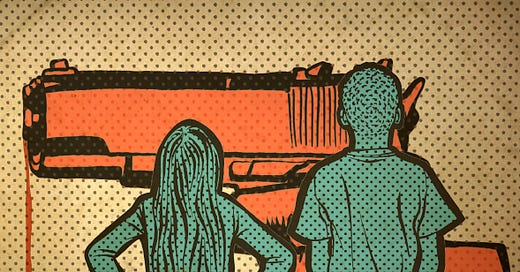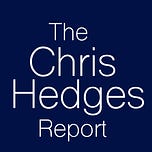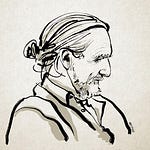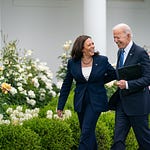Narrated by Eunice Wong
Text originally published 06/05/2022
“White Light/White Heat” - Mr. Fish
Guns were a ubiquitous part of my childhood. My grandfather, who had been a master sergeant in the army, had a small arsenal in his house in Mechanic Falls, Maine. He gave me a 2020 bolt action Springfield rifle when I was 7. By the time I was 10, I had graduated to a Winchester lever action 30-30. I moved my way up the National Rifle Association’s (NRA) Marksmanship Qualification Program, helped along by a summer camp where riflery was mandatory. Like many boys in rural America, I was fascinated by guns, although I disliked hunting. Two decades as a reporter in war zones, however, resulted in a deep aversion to weapons. I saw what they did to human bodies. I inherited my grandfather’s guns and gave them to my uncle.
Guns made my family, lower working-class people in Maine, feel powerful, even when they were not. Take away their guns and what was left? Decaying small towns, shuttered textile and paper mills, dead-end jobs, seedy bars where veterans, nearly all the men in my family were veterans, drank away their trauma. Take away the guns, and the brute force of squalor, decline, and abandonment hit you in the face like a tidal wave.
Yes, the gun lobby and weapons manufacturers fuel the violence with easily available assault-style weapons, whose small caliber 5.56 mm cartridges make them largely useless for hunting. Yes, the lax gun laws and risible background checks are partially to blame. But America also fetishizes guns. This fetish has intensified among white working-class men, who have seen everything slip beyond their grasp: economic stability, a sense of place within the society, hope for the future and political empowerment. The fear of losing the gun is the final crushing blow to self-esteem and dignity, a surrender to the economic and political forces that have destroyed their lives. They cling to the gun as an idea, a belief that with it they are strong, unassailable, and independent. The shifting sands of demographics, with white people projected to become a minority in the U.S. by 2045, intensifies this primal desire, they would say need, to own a weapon.
There have been over 200 mass shootings this year. There are nearly 400 million guns in the U.S., some 120 guns for every 100 Americans. Half of the privately-owned guns are owned by 3 percent of the population, according to a 2016 study. Our neighbor in Maine had 23 guns. Restrictive gun laws, and gun laws that are inequitably enforced, block gun ownership for many Blacks, especially in urban neighborhoods. Federal law, for example, prohibits gun ownership for most people with felony convictions, effectively barring legal gun ownership for a third of Black men. The outlawing of guns for Blacks is part of a long continuum. Blacks were denied the right to own guns under the antebellum Slave Codes, the post-Civil War Black Codes, and the Jim Crow laws.
White people built their supremacy in America and globally with violence. They massacred Native Americans and stole their land. They kidnapped Africans, shipped them as cargo to the Americas, and then enslaved, lynched, imprisoned, and impoverished Black people for generations. They have always gunned down Black people with impunity, a historical reality only recently discernable to most white people because of cell phone videos of killings.
“The essential American soul is hard, isolate, stoic and a killer,” D.H. Lawrence writes. “It has never yet melted.”
White society, sometimes overtly and sometimes unconsciously, deeply fears Black retribution for its four centuries of murderous assaults.
“Again, I say that each and every Negro, during the last 300 years, possesses from that heritage a greater burden of hate for America than they themselves know,” Richard Wright notes in his journal. “Perhaps it is well that Negroes try to be as unintellectual as possible, for if they ever started really thinking about what happened to them, they’d go wild. And perhaps that is the secret of whites who want to believe that Negroes really have no memory; for if they thought that Negroes remembered they would start out to shoot them all in sheer self-defense.”
The Second Amendment, as the historian Roxanne Dunbar-Ortiz writes in Loaded: A Disarming History of the Second Amendment,” was designed to solidify the rights, often demanded under state law, of whites to carry weapons. Southern white men were not only required to own guns but serve in slave patrols. These weapons were used to exterminate the indigenous population, hunt down enslaved people who escaped bondage and violently crush slave revolts, strikes and other uprisings by oppressed groups. Vigilante violence is wired into our DNA.
“Most American violence – and this also illuminates its relationship to state power – has been initiated with a ‘conservative’ bias,” the historian Richard Hofstadter writes. “It has been unleashed against abolitionists, Catholics, radicals, workers and labor organizers, Negroes, Orientals, and other ethnic or racial or ideological minorities, and has been used ostensibly to protect the American, the Southern, the white Protestant, or simply the established middle-class way of life and morals. A high proportion of our violent actions has thus come from the top dogs or the middle dogs. Such has been the character of most mob and vigilante movements. This may help to explain why so little of it has been used against state authority, and why in turn it has been so easily and indulgently forgotten.”
Payton Gendron, the 18-year-old white shooter in Buffalo who killed ten Black people and wounded three others, one of them Black, at the Tops Friendly Markets in a Black neighborhood, gave expression in a 180-page manifesto to this white fear, or “great replacement theory.” Gendron repeatedly cited Brenton Tarrant, the 28-year-old mass shooter who in 2019 killed 51 people and injured 40 others at two mosques in Christchurch, New Zealand. Tarrant, like Gendron, live streamed his attack so, he believed, he could be cheered on by a virtual audience. Robert Bowers, 46, killed 11 people at the Tree of Life Synagogue in Pittsburgh in 2018. Patrick Crusius, a 21-year-old, in 2019 drove more than 11 hours to target Hispanics, leaving 22 people dead and 26 injured in a Walmart in El Paso. John Earnest, who pleaded guilty to murdering one and injuring three others in 2019 at a synagogue in Poway, California, saw the “white race” being supplanted by other races. Dylann Roof in 2015 fired 77 shots from his .45-caliber Glock pistol at parishioners attending a Bible study at the Black Emanuel AME Church in Charleston, South Carolina. He murdered nine of them. “You Blacks are killing white people on the streets everyday and raping white women everyday,” he shouted at his victims as he was firing, according to a journal he kept in jail.
The gun enforced white supremacy. It should not be surprising that it is embraced as the instrument that will prevent whites from being dethroned.
The specter of societal collapse, less and less a conspiracy theory as we barrel to climate breakdown, reinforces the gun fetish. Survivalist cults, infused with white supremacy, paint the scenario of gangs of marauding Black and brown people fleeing the chaos of lawless cities and ravaging the countryside. These hordes of Black and brown people, the survivalists believe, will only be kept at bay with guns, especially assault-style weapons. This is not far removed from calling for their extermination.
Historian Richard Slotkin calls our national lust for blood sacrifice the “structuring metaphor of the American experience,” a belief in “regeneration through violence.” Blood sacrifice, he writes in his trilogy Regeneration Through Violence: The Mythology of the American Frontier, The Fatal Environment: The Myth of the Frontier in the Age of Industrialization, and Gunfighter Nation: The Myth of the Frontier in Twentieth-Century America, is celebrated as the highest form of good. Sometimes it requires the blood of heroes, but most often it requires the blood of enemies.
This blood sacrifice, whether at home or in foreign wars, is racialized. The U.S. has slaughtered millions of the globe’s inhabitants, including women and children, in Korea, Vietnam, Afghanistan, Somalia, Iraq, Syria and Libya, as well as in numerous proxy wars, the latest in Ukraine, where the Biden administration will ship another $ 700 million in weapons to supplement $54 billion in military and humanitarian aid.
When the national mythology inculcates into a population that it has the divine right to kill others to purge the earth of evil, how can this mythology not be ingested by naïve and alienated individuals? Kill them overseas. Kill them at home. The more the empire deteriorates, the more the impetus to kill grows. Violence, in desperation, becomes the only route to salvation.
“A people unaware of its myths is likely to continue living by them, though the world around that people may change and demand changes in their psychology, their world view, their ethics, and their institutions,” Slotkin writes.
America’s gun fetish and culture of vigilante violence makes the U.S. very different from other industrialized nations. This is the reason there will never be serious gun control. It does not matter how many mass shootings take place, how many children are butchered in their classrooms, or how high the homicide rate climbs.
The longer we remain in a state of political paralysis, dominated by a corporate oligarchy that refuses to respond to the mounting misery of the bottom half of the population, the more the rage of the underclass will find expression through violence. People who are Black, Muslim, Asian, Jewish, and LGBTQ, along with the undocumented, liberals, feminists and intellectuals, already branded as contaminants, will be slated for execution. Violence will spawn more violence.
“People pay for what they do, and, still more, for what they have allowed themselves to become,” James Baldwin writes of the American South. “The crucial thing, here, is that the sum of these individual abdications menaces life all over the world. For, in the generality, as social and moral and political and sexual entities, white Americans are probably the sickest and certainly the most dangerous people, of any color, to be found in the world today.” He added that he “was not struck by their wickedness, for that wickedness was but the spirit and the history of America. What struck me was the unbelievable dimension of their sorrow. I felt as though I had wandered into hell.”
Those who cling to the mythology of white supremacy cannot be reached through rational discussion. Mythology is all they have left. When this mythology appears under threat it triggers a ferocious backlash, for without the myth there is an emptiness, an emotional void, a crushing despair.
America has two choices. It can reintegrate the dispossessed back into the society through radical New Deal types of reforms, or it can leave its underclass to wallow in the toxins of poverty, hate and resentment, fueling the blood sacrifices that afflict us. This choice, I fear, has already been made. The ruling oligarchy doesn’t take the subway or fly on commercial jets. It is protected by the FBI, Homeland Security, police escorts, and bodyguards. Its children attend private schools. It lives in gated communities with elaborate surveillance systems. We don’t matter.















Share this post